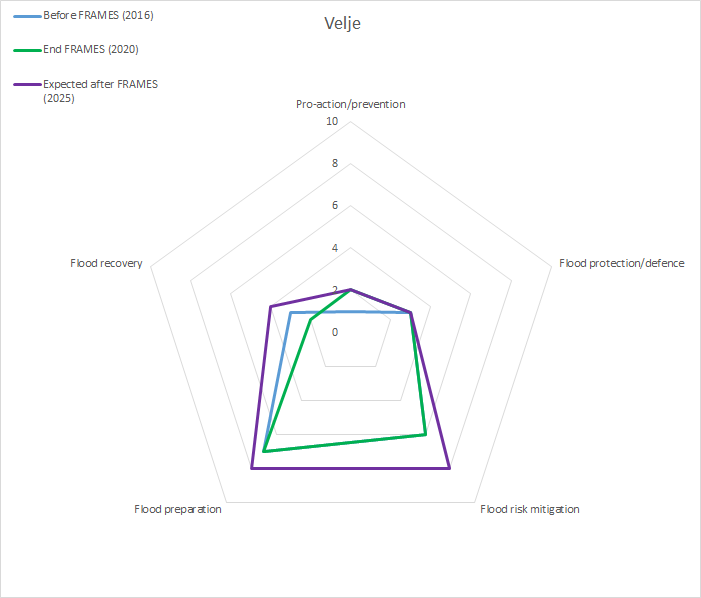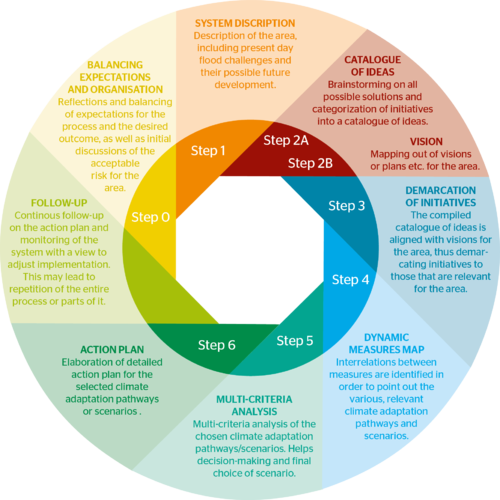LC 00288: verschil tussen versies
Geen bewerkingssamenvatting |
Geen bewerkingssamenvatting |
||
| Regel 12: | Regel 12: | ||
[[Bestand:Vejle web final.png|kaderloos|701x701px]] | [[Bestand:Vejle web final.png|kaderloos|701x701px]] | ||
''Figure 1: Initial, final and expected scores | ''Figure 1: Initial, final and expected scores per layer in this pilot ({{Cite|resource=Bestand:FRAMES Monitoring Survey 10A Vejle Completed.pdf|name=Baseline survey, 2019|dialog=process-file-dialog}}, {{Cite|resource=Bestand:Transnational Monitor and Evaluation report FRAMES (HZ June 2020).pdf|name=Transnational Monitor and Evaluation report|dialog=process-file-dialog}}, 2020)'' | ||
To measure the impact of FRAMES on improving the flood resilience of pilot areas, communities and authorities both a baseline and final monitoring survey have been conducted. The surveys were completed by pilot managers in consultation with key pilot stakeholders. The baseline survey included questions about the actual situation in 2017 (before the project started) and expectations for 2020 (expectations were not filled out for this particular pilot) (see figure 1). The final survey contained similar questions, but about the actual situation in 2020 and expected situation for 2025, five years after the pilot projects are finished. All the scores for both surveys along with an interpretation, can be found in chapter 8 of | To measure the impact of FRAMES on improving the flood resilience of pilot areas, communities and authorities both a baseline and final monitoring survey have been conducted. The surveys were completed by pilot managers in consultation with key pilot stakeholders. The baseline survey included questions about the actual situation in 2017 (before the project started) and expectations for 2020 (expectations were not filled out for this particular pilot) (see figure 1). The final survey contained similar questions, but about the actual situation in 2020 and expected situation for 2025, five years after the pilot projects are finished. All the scores for both surveys along with an interpretation, can be found in chapter 8 of the {{Cite|resource=Bestand:Transnational Monitor and Evaluation report FRAMES (HZ June 2020).pdf|name=Transnational Monitoring and Evaluation Report|dialog=process-file-dialog}}. | ||
=== Stakeholders involved === | === Stakeholders involved === | ||
* {{External link|resource=Resource Hyperlink 00458|name=Danish Coastal Authority|dialog=process-linkwebsite-dialog}} | * {{External link|resource=Resource Hyperlink 00458|name=Danish Coastal Authority|dialog=process-linkwebsite-dialog}} | ||
Huidige versie van 3 jul 2020 om 11:52
By looking at the the activities, actors and methods or approaches used, this section will provide a better understanding of the implementation process of the MLS approach. We will describe the point of departure, who was involved (when, why and how) and what key decisions were made when and why.
Point of departure of FRM strategies
There is a sluice in the water course Omløbsåen, and small dikes along parts of the rivers in the height of 2 m to prevent flooding from the water courses (interview pilot manager, 2019). When closed, the flood gate will prevent high water levels in the fjord from entering Omløbsåen, where it otherwise would cause flooding. Three motor-driven sluice gates are also located further upstream in Omløbsåen, allowing automated and remote control. However, sea-levels are expected to rise by 25 cm in the fjord by 2050, and it is at serious risk of flooding due to its low-level topography (DHI, 2019).
Currently, protection from the side of the fjord is on the agenda. Options discussed (DCA with the Vejle Municipality) are a sea wall barrier, also the option to protect the harbour area, cutting off the harbor area or a major storm surge barrier in the same area that will close up the entire city during a storm surge. The storm surge barrier would cross the entire fjord and also function as a green area. One solution would be to have a sluice to hold back the water (interview pilot manager, 2019)
The new parts of the cities are built on raised terrain and they are also building higher foundations for the houses. This makes these areas flood proof without building a sea wall, but it might not be high enough considering the expected sea rise level (interview pilot manager, 2019).
This area was chosen as part of the project because it is an area of potential significant flood risk as part of the Floods Directive and it is a member of the list of 100 resilient cities.
Figure 1: Initial, final and expected scores per layer in this pilot (Baseline survey, 2019, Transnational Monitor and Evaluation report, 2020)
To measure the impact of FRAMES on improving the flood resilience of pilot areas, communities and authorities both a baseline and final monitoring survey have been conducted. The surveys were completed by pilot managers in consultation with key pilot stakeholders. The baseline survey included questions about the actual situation in 2017 (before the project started) and expectations for 2020 (expectations were not filled out for this particular pilot) (see figure 1). The final survey contained similar questions, but about the actual situation in 2020 and expected situation for 2025, five years after the pilot projects are finished. All the scores for both surveys along with an interpretation, can be found in chapter 8 of the Transnational Monitoring and Evaluation Report.
Stakeholders involved
- Danish Coastal Authority
- Municipality of Vejle
- Department of Technology and Environment
- PhD student from Aarhus University, focusing on awareness raising
Role of key actors
The Danish Coastal Authority is an independent agency under the Danish Ministry of Environment and Food. The authority’s functions include analysis and guidance on coastal and flooding protection and the administration of the state territorial waters. Moreover, the Danish Coastal Authority functions as adviser to The Minister of Environment and Food.
In this project, the DCA worked together with the municipality. The municipality was very interested and collaborative in working together with the DCA and gave valuable input to the development of the DAPP steps.
Main activities
First, the DCA had to find out the way to work with the Dynamic Adaptive Pathways approach (DAPP) since it was not applied for very specific contexts in flood risk management (FRM) in a Danish context. So a workshop was organized where Deltares, the developer of this method, brainstormed with the DCA on how to implement this approach in Vejle. The following steps have been taken (see figure below from the DCA):
Step 0 is about alignment of expectations and is useful for reflections and discussions about the desired outcome of the dynamic planning process. This step should clarify the purpose of the work and ensure that the work group has the mandate required to carry through the task. It is essential to a successful process that suitable resources are available both in terms of time and manpower.
Step 1 is a description of the target area for the planning process and the system, which influences that area. The purpose of this initial step is to create a joint understanding of the area and present day flood challenges, how these challenges may develop in future, as well as the uncertainties involved.
Step 2 consists of two parts. Part one, Step 2A, is a general brainstorming process to come up with ideas of how to handle flood challenges. These ideas are then sorted into relevant categories and organised into a catalogue of ideas. The second part, Step 2B, is an overview of visions, plans ect., already in place for the area, in order to align solutions generated in the course of the process with existing visions and planning.
Step 3 is a revision of Step 2, with a view to demarcate or broaden the possible initiatives compiled the catalogue of ideas in line with visions mapped out. This should ensure weeding out of initiatives that contend with the general development plans for the area.
Step 4 is a compilation and sorting of initiatives. The aim is to find initiatives that match the visions for the town and reduce the risk at the same time. This should demonstrate the interrelation between the various initiatives, as well as their mutual dependencies. This is the platform from which the desired climate adaptation paths are chosen. This step may also be useful in clarifying any general scenarios suitable for communication work or for further discussion at the political level.
Step 5 is a multi-criteria analysis (MCA) for a limited number of selected pathways from the map of measures. At this stage it will be beneficial to include weighting by stakeholders and politicians, since the multi-criteria analysis is a decision-making tool, designed to find the desired climate adaptation pathways for the area.
Step 6 is the elaboration of a detailed action plan for the work with the climate adaptation pathways or scenarios selected based on the completed process and the multi-criteria analysis.
Step 7 is a follow-up.Once the process is completed, a continuous follow-up and monitoring of the system should be initiated. System changes, requirement for a more detailed perspective or new insights gathered along the way may mean that the process will have to be repeated. This will ensure that the plan and it implementation are adjusted, when necessary.
Every step required one full day meeting with the municipalities, except step 4 which required a 3 days meeting. The municipality was very reactive and cooperative in the whole process, they are very interested in working with the method and give input on the method to DCA.
The result will be presented to the Danish municipalities, during meetings and by a guide on running the Dynamic Planning Process. Some results are Incorporated in the guide for making flood risk management plans for the municipalities appointed as APSFRs under the Floods Directive, and, when applicable, when the DCA performs risk management plans in other municipalities.


